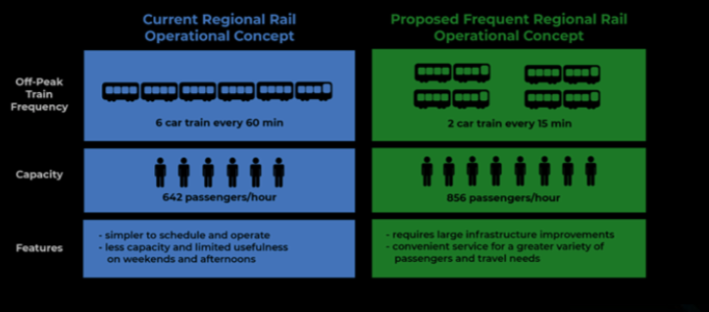Mayor Jim Kenney, other Philadelphia officials, regional partners, and the Southeastern Pennsylvania Transportation Authority released a road map on Monday for how to increase ridership on buses, streetcars, subways, and regional rail as part of its 192-page "Philadelphia Transit Plan, A Vision for 2045."
Included is a plan to start running the city's suburban regional rail system like, well, a regional rail system.
For an American city, Philadelphia has an incredibly comprehensive, electrified regional commuter rail network, with 13 branches and more than 150 stations. Originally, the trains ran into two center city railway stations. In 1984, Philly completed the 1.7-mile Center City Commuter Connection tunnel, a four-track subway to bring those lines together and integrate them with the city's transit system. There are four stations on this regional-rail throat, with frequent headways.
The idea was to transform the city's suburban trains into the equivalent of a Paris RER or the S-Bahns of Germany. These systems route commuter trains on multiple lines into a subway tunnel with multiple stops spread across the city's core. That gives suburban commuters one-seat options to alight at multiple locations in the city's core and, because of the combined headways, the trains double as frequent express subways.
It's that last part Philadelphia never managed to get right.
The fares and operations on SEPTA's regional system were never adjusted to the RER idea. Say someone arrives on Amtrak at 30th Street Station and then wants to head to Temple University. It's $5.25, more than twice the regular transit fare, for the 15-minute ride through the Center City tunnel. Moreover, "sometimes crew changes are done in the regional rail tunnel, so you could wait," explained Christopher Puchalsky, of Philadelphia's Office of Transportation, Infrastructure and Sustainability.
Or one can do the trip on Philadelphia's regular subway and bus lines, run by a different division of SEPTA. That requires changing trains, takes over 20 minutes, and costs $2.25.

Even pre-COVID, SEPTA ran each branch line once an hour outside of 9-to-5 peak times. In other words, the tunnel portion of regional rail is set up physically like an S-Bahn or the RER of Paris, but trains still run and are priced like a typical American commuter train system.
For the Philadelphia Transit Riders Union, the pricing and headways are a discriminatory policy that keeps riders segregated. "SEPTA Regional Rail never ran high service frequencies because it chose to cater only to mostly White, wealthy commuters. SEPTA runs 15-20 minute headways for them at rush hour — they could do that for everybody," wrote Nat Lownes, the organization's coordinating committee member.
And Joy Huertas, a spokesperson for the mayor's office, added that the RER-type service "was never fully realized."
"This plan in many ways returns to this vision and updates it for the 21st century," Huertas said.
The new transit plan proposes breaking up the regional system's long, hourly trains into shorter consists and running them every 15 minutes. The shorter trains would be run by a single operator, instead of an operator and multiple conductors/ticket collectors.
The combined headways in the tunnel would result in service every couple of minutes, at all hours. The trunk line would be rebranded as the "silver line" and would be priced the same as the subway, with transfers included. Only riders who continue to the suburbs would be expected to pay an additional fare. "This type of service is critical for people making transfers, working non-9-to-5 jobs, and taking transit for non-work trips," said Mike Carroll, Deputy Managing Director for Transportation. "Frequency is freedom. How often a bus or train arrives is one of the key factors in how useful it is."
The new plan is about more than regional rail: it also recommends an expansion and modernization of Philadelphia's streetcar system and it prescribes transit-only lanes and signal priority for its buses. For more on that, check out PlanPhilly's coverage.
Meanwhile, to turn its regional rail system into a true RER, the city needs lighter, faster trains, new operating agreements with some of the railroads with which it shares tracks, and improved switches and signals. It also needs level-boarding at all its stations, something rare outside of the tunnel. That alone would cost $2 billion. As the study authors caution, many of the improvements will require "...a sea change in budget and policy at the Federal, State, or regional level" when it comes to funding transit.
Huertas told Streetsblog the next step will be to study the detailed costs and how to phase in the cheaper, operational improvements.







